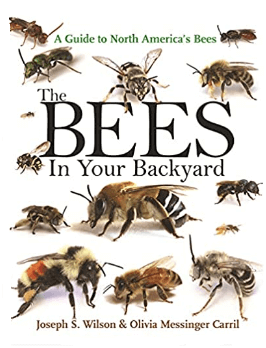Table of Contents:
Do Bumble Bees Bite?
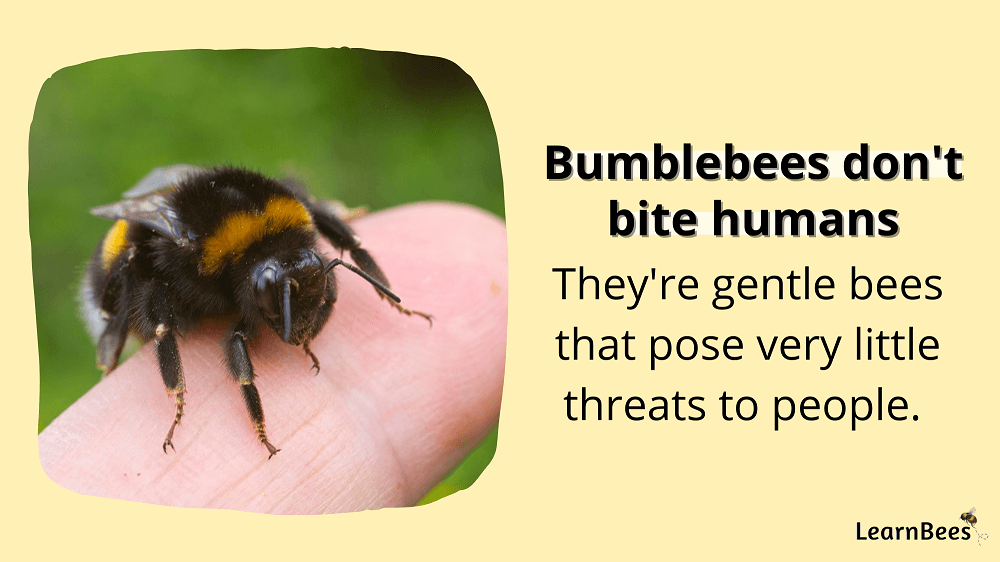
Ready for some good news?
No, bumblebees don’t bite humans. It simply isn’t their natural instinct to do so.
What do I mean by that?
For starters, bumblebees are actually gentle bees that aren’t confrontational. Despite this, they can make people nervous because they’re larger than other bees. In fact, queen bumblebees and carpenter bees are the largest native bees in the United States.
But don’t worry.
Bumblebees are nicknamed “gentle giants” due to their size and passive nature. They’re curious creatures that might buzz around you quickly, but they aren’t aggressive. The trick is to stay still and don’t swat at them. Simply allow the bumblebee to be curious for a second, and then it’ll go about its business.
Now let’s be clear:
Bumblebees have stingers just like other bees do. But, they only use their stingers as a defense mechanism when they feel seriously threatened. This can happen if you’re touching them or poking around their nest.
So while bumblebees can sting humans, it’s unlikely to happen due to their docile nature. For example, I feel perfectly safe picking berries from my blueberry bush while it’s covered in bumblebees. We coexist peacefully together.
It’s as simple as that.
Now you might be asking…
Do Bumble Bees Have Teeth?
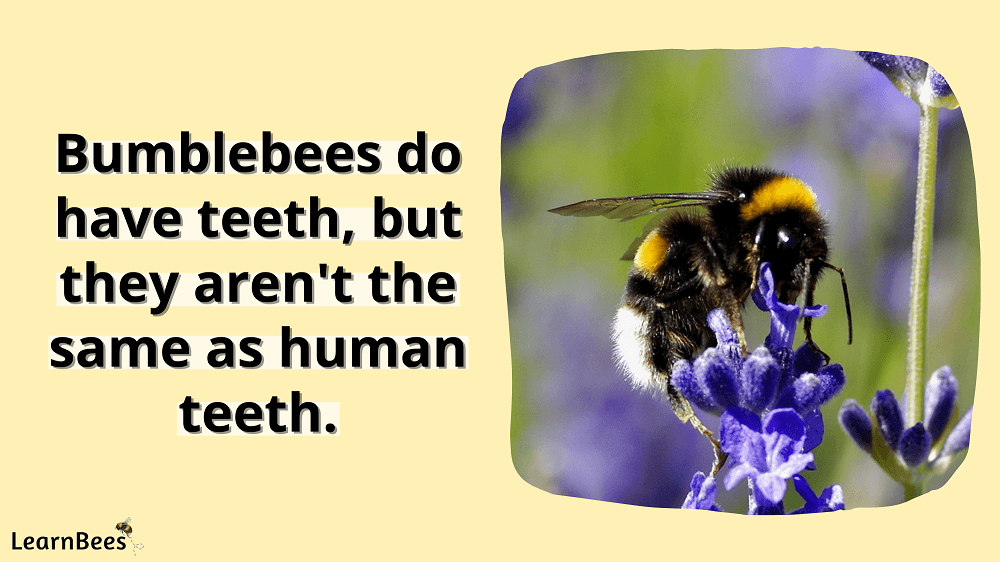
Yes, bumblebees have teeth, but they’re different than human teeth.
Consider this.
Human teeth are made of three things:
- Enamel – The rock-hard mineral that forms the outer part of your tooth.
- Dentin – The next layer of your tooth that’s made of living cells.
- Pulp – The center of your tooth where nerves and blood vessels live.

If you look inside a bumblebee’s mouth, you won’t find white teeth made of enamel, dentin, and pulp. Instead, you’ll see sharp edges on their jaws (mandibles). These sharp edges act like teeth, allowing bumblebees to cut into flowers to gather nectar.
The mandibles (jaws) look like tiny pinchers.
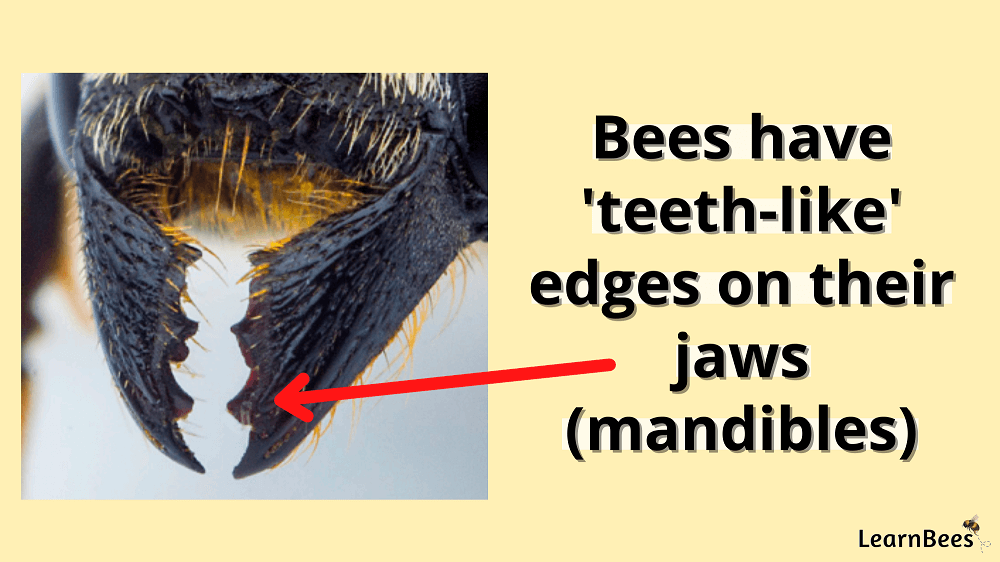
There you have it.
Those sharp edges are considered ‘bee teeth.’
Now I can hear you wondering:
Well, if bees have teeth that they don’t use to bite humans…then what do they use them for?
Good question. Let’s talk about that next.
When Do Bumble Bees Bite?
As mentioned, bumblebees don’t bite humans, but they do have teeth that come in handy for daily tasks.
So what do they use their teeth for?
A few things:
1. Bumblebees bite into plants to get them to bloom faster
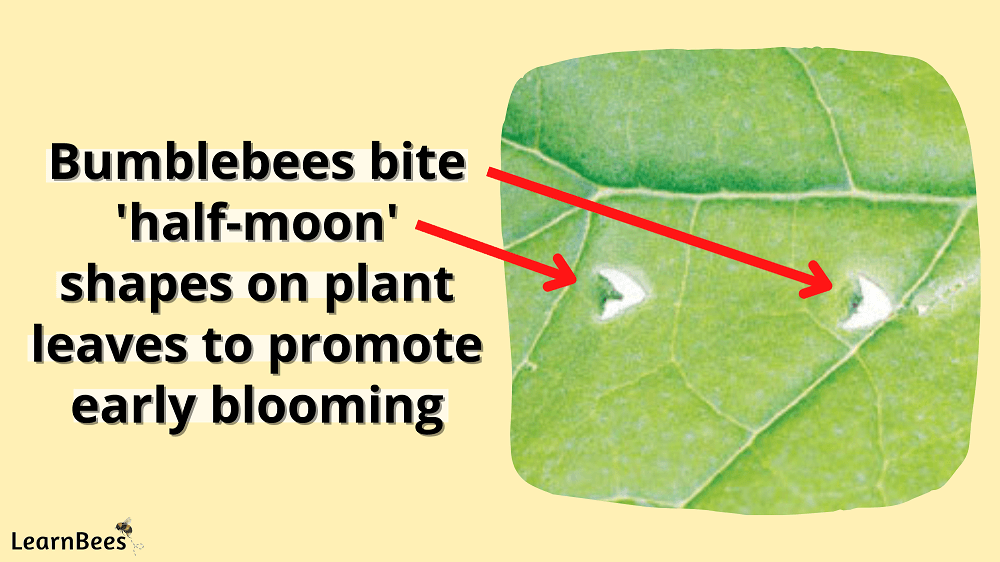
Bumblebees aren’t merely bumbling around flowers. They work hard and intentionally, often over 10 hours per day, to collect pollen and nectar.
The only problem?
Sometimes there is a lack of nectar and pollen resources when plants aren’t blooming. To fix this, bumblebees sometimes chew tiny ‘half-moon’ shapes into plant leaves. In turn, this encourages the plants to flower weeks earlier than they usually would.
And as a result?
The bumblebees are supplied with food. And interestingly enough, other types of bees haven’t been observed doing this chewing behavior like bumblebees do. For example, honeybees simply ignore plants that don’t have blooms. They don’t bite the leaves like bumblebees do.
Now here’s the thing:
Some say this chewing behavior harms plants.
But this isn’t necessarily the case.
In fact, researchers are curious why these half-moon cuttings encourage early flowering. Is it a reaction triggered by the fatty acids in a bumblebees saliva? Is it an unknown chemical cue?
We don’t know yet.
But Lars Chittka, a professor of Sensory and Behavioural Ecology at Queen Mary University, says this about bumblebees’ chewing behavior:
“Scientists might realize a horticulturist’s dream by deciphering the molecular pathways through which flowering can be accelerated by a full month.”(1)
2. Bumblebees make incisions into flowers to sip on hard-to-reach nectar
Let’s face it.
Bumblebees are industrious little creatures.
Not only do they bite into plant leaves to get them to bloom faster, but they also bite into flowers to get nectar. This is necessary when the shape of the flower makes accessing nectar tricky.
Sometimes, a bumblebee’s tongue isn’t long enough to reach the food source. So cutting a small hole in the base of the flower does the trick. This is especially true for certain bumblebee species with shorter tongues.
3. Bumblebees bite flowers during buzz pollination

You didn’t think we were done, did you?
Nope. As it turns out, bumblebees use their teeth for pollination.
Here’s what they do:
The bumblebee bites down at the base of the anther, where the pollen is located. She then vibrates her body in a process we call buzz pollination – or sonication. These vibrations shake the pollen upwards out of the flower. From there, the pollen collects on her fuzzy body.
As the bumblebee cleans herself, she’ll store the excess pollen in special ‘pollen baskets’ on her hindlegs. This allows her to bring back pollen to feed her colony members.
Even better?
Buzz pollination benefits both bumblebees and the plant they visit. The bees get fed, and the plants get fertilized so they can reproduce.
4. Bumblebees bite their way out of cocoons
Like butterflies, bumblebees get wrapped in cocoons.
Here’s the process:
The queen bumblebee finds a safe nesting spot – usually underground in empty mouse burrows or vegetation. She then lays eggs and covers them with wax. Next, she uses her wing muscles to buzz quickly and generate heat. This is how she keeps the eggs warm.
The queen bumblebee incubates her eggs for four days until the larvae hatch. Once the larvae hatch, they eat pollen and grow quickly.
But it’s not over just yet.
The larvae still haven’t developed into adult bumblebees. It takes them a few weeks to complete this process, and they shed their skin three times during this time.
Next, they make like butterflies and wrap themselves in a silk cocoon. This allows them to undergo a metamorphosis which is where they transform from worm-like creatures into bees. They form legs, wings, and other bee body parts.
And after two weeks?
The young bumblebees nibble their way out of their cocoons.
The first generation of bumblebees is born in the spring. They’re all female worker bumblebees with plenty of work to do, such as forage for food and cleaning and protecting their nest.
Later on, the queen will lay eggs that become male bees and future queen bees.
FAQs on “Do Bumble Bees Bite?”
- Do bumble bees bite into wood?
- What does a bumblebee bite look like?
- Do bumble bees bite if they’re aggressive?
- Do bumble bees bite insects?
Do bumble bees bite into wood?
No, bumblebees don’t bite into wood.
When people ask this, it’s usually because they’re mistaking bumblebees for carpenter bees. Bumblebees and carpenter bees look alike because they’re both large bees that can have similar coloring.
But carpenter bees and bumblebees are different bee species. Also, they have different nesting habits.
For example, carpenter bees do bite into wood to build their nests. This is why you might see small, neat holes in the wood around your home.
If you’re seeing bees near wood and aren’t sure if they’re carpenter bees or bumblebees, look closely at their behavior. If the bee is chewing into the wood, it’s a carpenter bee – not a bumblebee.
(If you want to deter carpenter bees naturally, read our guide: How to Deter Carpenter Bees Without Harming Them)
Bumblebees nest underground in empty holes left behind by rodents and other animals.
—> Go back to the FAQs on “Do Bumble Bees Bite?”
More to Explore:
- Honeybees vs. Bumblebees: How Do They Compare?
- What Do Bumble Bees Eat?
- Do Carpenter Bees Pollinate?
What does a bumblebee bite look like?
Bumblebees don’t bite humans, so we don’t have descriptions of what that would look like. That said, bumblebees bite plant leaves and flowers. These bites leave behind small ‘half-moon’ shapes on plant leaves.
Why do they do this?
Because chewing into plant leaves encourages the plants to bloom weeks earlier than they would otherwise. Bumblebees need pollen and nectar to survive. So if blooming flowers are scarce, they use this handy chewing behavior to help.
And as a result?
The bumblebees are fed. And surprisingly enough, other bees haven’t been observed chewing in this manner. For instance, honeybees were discovered to just pass over plants that didn’t produce blossoms.
Now here’s the thing:
Some people claim that this chewing causes damage to plants.
But this isn’t necessarily true.
In fact, scientists are more curious than they are concerned. Why do these half-moon cuttings produce flowers early? Is it a reaction to the fatty acids in bumblebee saliva? Is it a chemical signal that no one knows about?
We don’t have all the answers yet.
But Lars Chittka, a professor of Sensory and Behavioural Ecology at Queen Mary University, says this:
“Scientists might realize a horticulturist’s dream by deciphering the molecular pathways through which flowering can be accelerated by a full month.”(2)
—> Go back to the FAQs on “Do Bumble Bees Bite?”
More to Explore:
Do bumble bees bite if they’re aggressive?
No, don’t worry. Bumblebees don’t bite humans and they aren’t aggressive.
We get this question often asked, along with other questions like:
Do bumble bees bite or sting? Can a bumblebee bite you? Do bumble bees sting or bite? Do bumblebees bite humans? Do male bumblebees bite? Do black bumblebees bite?
Rest assured:
Bumblebees won’t bite you. They only use their teeth for daily activities such as gathering food or nesting.
—> Go back to the FAQs on “Do Bumble Bees Bite?”
More to Explore:
Do bumble bees bite insects?
Generally speaking, no. A bumblebee’s main defense mechanism is its stinger. Unlike honeybees, bumblebees can sting multiple times without dying. This is because they don’t have barbed stingers that ‘hook’ into insects, animals, or people.
So when bumblebees sting, they can safely pull out their stinger without harming themselves.
And as for bumblebees biting insects to eat them, this doesn’t happen either. A bumblebee’s primary diet consists of pollen, nectar, and honey. They don’t eat meat or insects like wasps do.





